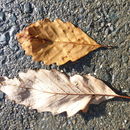en
names in breadcrumbs


The four species of the chestnut oak group in eastern North America ( Quercus montana , Q . michauxii , Q . muhlenbergii , and Q . prinoides ) are somewhat difficult to distinguish unless careful attention is paid to features of leaf vestiture and fruit and cup morphology. Attempts to identify these species mostly or solely on basis of leaf shape and dentition (as in many other oak species complexes) have resulted in a plethora of misidentified material in herbaria and erroneous reports in the literature. The closely appressed, asymmetric trichomes on the abaxial surface of the mature leaf, in combination with longer simple hairs along the midvein, are unique to Q . montana among North American species of Quercus . Immature leaves and densely shaded leaves sometimes exhibit a more erect trichome that could be confused with the longer, felty hairs of Q . michauxii , so it is important to evaluate mature sun leaves when possible.
Quercus montana, the chestnut oak, is a species of oak in the white oak group, Quercus sect. Quercus. It is native to the eastern United States, where it is one of the most important ridgetop trees from southern Maine southwest to central Mississippi, with an outlying northwestern population in southern Michigan. It is also sometimes called rock oak because of its presence in montane and other rocky habitats.
As a consequence of its dry habitat and ridgetop exposure, Quercus montana is not usually a large tree, typically growing to 18–22 metres (59–72 feet) tall; specimens growing in better conditions can grow up to 40–43 m (131–141 ft) tall. They tend to have a similar spread of 18–22 m (59–72 ft). A 10-year-old sapling grown in full sun will stand about 5 m (16 ft) tall. This species is often an important canopy species in an oak-heath forest.[4][5]
It is readily identified by its massively-ridged dark gray-brown bark, the thickest of any eastern North American oak. The leaves are 12–20 centimetres (4+3⁄4–7+3⁄4 inches) long and 6–10 cm (2+1⁄4–4 in) broad, shallowly lobed with 10–15 rounded lobes on each margin; they are virtually identical to the leaves of swamp chestnut oak and chinkapin oak, but the trees can readily be distinguished by the bark, that of the chinkapin oak being a light ash-gray and somewhat peeling like that of the white oak and that of swamp chestnut oak being paler ash-gray and scaly. The chinkapin oak also has much smaller acorns than the chestnut oak. The chestnut oak is easily distinguished from the swamp white oak because that tree has whitened undersides on the leaves. Another important distinction between the chestnut oak and the swamp chestnut oak is by the habitat; if it grows on a ridge, it is chestnut oak, and if it grows in wet bottomlands, it is probably the more massive swamp chestnut oak; however, this is not fully reliable.
Characteristics include:[6]
The acorns of the chestnut oak are 1.5–3 cm (1⁄2–1+1⁄4 in) long and 1–2 cm (3⁄8–3⁄4 in) broad,[7] among the largest of Native American oaks, surpassed in size only by the bur oak and possibly swamp chestnut oak.
Extensive confusion between the chestnut oak (Quercus montana) and the swamp chestnut oak (Quercus michauxii) has occurred, and some botanists have considered them to be the same species in the past.
The name Quercus prinus was long used by many botanists and foresters for either the chestnut oak or the swamp chestnut oak, with the former otherwise called Q. montana or the latter otherwise called Q. michauxii. The application of the name Q. montana to the chestnut oak is now accepted, since Q. prinus is of uncertain position, unassignable to either species.[7][8][9][10]
The Latin specific epithet montana refers to mountains or coming from mountains which probably refers to the tree's habitat and its ability to grow on rocks.[11]
This species is a predominant ridge-top tree in eastern North American hardwood forests. Young chestnut oaks are easily capable of reproducing from stump sprouts if cut. A significant amount of chestnut oaks in the Appalachians are trees that regrew from stump sprouts after being logged. It is a long-lived tree, with high-quality timber when well-formed. The acorns of the chestnut oak are a valuable wildlife food.[12]
Chestnut oak trees are generally not the best timber trees because they are usually branched low and not very straight, but when they grow in better conditions, they are valuable for timber, which is marketed as 'mixed white oak'. The bark of chestnut oak has a high tannin content and prior to the 20th century was heavily used in the leather tanning industry, but the wood was usually discarded since it was considered inferior to that of Q. alba. By the late 19th century, as the population of mature white oaks in the eastern US was dwindling, loggers began exploiting chestnut oak wood more heavily. It serves many of the same applications as white oak wood and as it is fairly rot-proof, has also been used for fencing, railroad ties, and other uses where the wood comes into contact with soil. Due to a relatively high density (21 kg or 47 lb per cu. ft), chestnut oak makes excellent firewood.
The acorns can be eaten by humans but, if bitter, may need to have the tannins leached.[13]
Quercus montana, the chestnut oak, is a species of oak in the white oak group, Quercus sect. Quercus. It is native to the eastern United States, where it is one of the most important ridgetop trees from southern Maine southwest to central Mississippi, with an outlying northwestern population in southern Michigan. It is also sometimes called rock oak because of its presence in montane and other rocky habitats.